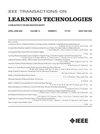在教育移动虚拟现实中嵌入测试问题:医院卫生程序研究
IF 4.9
3区 教育学
Q2 COMPUTER SCIENCE, INTERDISCIPLINARY APPLICATIONS
引用次数: 0
摘要
教育虚拟环境(EVE)可以利用非沉浸式虚拟现实技术(VR),在包括智能手机在内的各种设备上实现有效的学习体验。为此,研究人员和教育工作者应找出最合适的教学技术,而不是从头开始,而是探索哪些传统的电子学习和 VR 技术可以有效地结合或适用于 EVE。在这个方向上,本文探讨了试题作为一种典型的电子学习技术,能否通过精心的混合设计在电子游戏中得到有效应用。我们还考虑了程序(一种典型的虚拟现实技术)的积极表现,以评估测试问题是否能与之协同增效,或者它们是否会打破存在感并不利于学习。在我们描述的主体间研究中,120 名参与者在四种条件下进行了学习:有/无测试问题和主动/被动程序表现。EVE在智能手机上运行,使用非沉浸式VR,教授预防传染病的手部卫生程序。结果表明,引入测试问题并没有破坏存在感,反而出人意料地提高了存在感,尤其是在与主动程序表现相结合时。无论在什么条件下,参与者在使用 EVE 后的自我效能感都有所提高,而不同的条件并没有显著改变参与度。此外,在学习迁移评估中,在电子学习环境中回答过测试问题的参与者减少了遗漏步骤的数量。最后,测试问题提高了参与者的满意度。总之,这些超出预期的益处支持在基于非沉浸式 VR 的 EVE 中采用建议的测试问题设计。本文章由计算机程序翻译,如有差异,请以英文原文为准。
Embedding Test Questions in Educational Mobile Virtual Reality: A Study on Hospital Hygiene Procedures
Educational virtual environments (EVEs) can enable effective learning experiences on various devices, including smartphones, using nonimmersive virtual reality (VR). To this purpose, researchers and educators should identify the most appropriate pedagogical techniques, not restarting from scratch but exploring which traditional e-learning and VR techniques can be effectively combined or adapted to EVEs. In this direction, this article explores if test questions, a typical e-learning technique, can be effectively employed in an EVE through a careful well-blended design. We also consider the active performance of procedures, a typical VR technique, to evaluate if test questions can be synergic with it or if they can instead break presence and be detrimental to learning. The between-subject study we describe involved 120 participants in four conditions: with/without test questions and active/passive procedure performance. The EVE was run on a smartphone, using nonimmersive VR, and taught hand hygiene procedures for infectious disease prevention. Results showed that introducing test questions did not break presence but surprisingly increased it, especially when combined with active procedure performance. Participants’ self-efficacy increased after using the EVE regardless of condition, and the different conditions did not significantly change engagement. Moreover, participants who had answered test questions in the EVE showed a reduction in the number of omitted steps in an assessment of learning transfer. Finally, test questions increased participants’ satisfaction. Overall, these greater-than-expected benefits support the adoption of the proposed test question design in EVEs based on nonimmersive VR.
求助全文
通过发布文献求助,成功后即可免费获取论文全文。
去求助
来源期刊

IEEE Transactions on Learning Technologies
COMPUTER SCIENCE, INTERDISCIPLINARY APPLICATIONS-
CiteScore
7.50
自引率
5.40%
发文量
82
审稿时长
>12 weeks
期刊介绍:
The IEEE Transactions on Learning Technologies covers all advances in learning technologies and their applications, including but not limited to the following topics: innovative online learning systems; intelligent tutors; educational games; simulation systems for education and training; collaborative learning tools; learning with mobile devices; wearable devices and interfaces for learning; personalized and adaptive learning systems; tools for formative and summative assessment; tools for learning analytics and educational data mining; ontologies for learning systems; standards and web services that support learning; authoring tools for learning materials; computer support for peer tutoring; learning via computer-mediated inquiry, field, and lab work; social learning techniques; social networks and infrastructures for learning and knowledge sharing; and creation and management of learning objects.
 求助内容:
求助内容: 应助结果提醒方式:
应助结果提醒方式:


